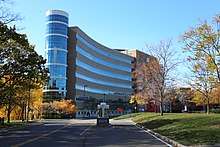Cornell University Center for Advanced Computing
The Cornell University Center for Advanced Computing (CAC), housed at Frank H. T. Rhodes Hall on the campus of Cornell University, is one of five original centers in the National Science Foundation's Supercomputer Centers Program. It was formerly called the Cornell Theory Center.

History
The CTC was established in 1985 under the direction of Cornell Physics Professor and Nobel Laureate Kenneth G. Wilson. In 1984, the National Science Foundation began work on establishing five new supercomputer centers, including the CTC, to provide high-speed computing resources for research within the United States. In 1985, a team from the National Center for Supercomputing Applications began the development of NSFNet, a TCP/IP-based computer network that could connect to the ARPANET at Cornell University and the University of Illinois at Urbana–Champaign. This high-speed network, unrestricted to academic users, became a backbone to which regional networks would be connected. Initially a 56-kbit/s network, traffic on the network grew exponentially; the links were upgraded to 1.5-Mbit/s T1s in 1988 and to 45 Mbit/s in 1991. The NSFNet was a major milestone in the development of the Internet and its rapid growth coincided with the development of the World Wide Web.[1][2] In the early 1990s, in addition to support from the National Science Foundation, the CTC received funding from the Advanced Research Projects Agency, the National Institutes of Health, New York State, IBM Corporation, SGI, and members of the center's Corporate Research Institute.[3] The center's focus was on developing scalable parallel computing resources for its user community and applying their expertise in parallel algorithm development and optimization to a wide range of scientific and engineering problems.
Achievements
CAC and its predecessor CTC have achieved a number of firsts, including deploying the first IBM Scalable POWERparallel System SP2 supercomputer, deploying the first Dell supercomputer, installing the first parallel version of MATLAB (MultiMATLAB) designed with the MATLAB product, establishing the first financial solutions center for supercomputing, and designing and running the first parallel job scheduler for Windows.[4]
Today, CAC is a partner on the National Science Foundation XSEDE project, a comprehensive collection of integrated digital resources and services enabling open science research. CAC is also developing training for TACC's Frontera supercomputer, serving as the technical lead for the Scalable Cyberinfrastructure Institute for Multi-Messenger Astrophysics (SCiMMA) project, developing software for the Institute for Research and Innovation in Software for High Energy Physics (IRIS-HEP), and serving as cyberinfrastructure design lead for the NANOGrav Physics Frontiers Center.
A 175 times faster computation of a CDC hepatitis C model on a CAC MATLAB cloud ranked among the top 50 innovations of the decade and was featured in the International Data Corporation's What the Exascale Era Can Provide report.[5] Other CAC awards include the Red Hat Innovation Award for best storage implementation and an IDC HPC Innovation Award sponsored by the Council on Competitiveness, DOD, DOE, NSF, and industry. CAC was an early implementer of cloud computing with the deployment of Red Cloud used by academe and industry. CAC also designed and deployed one of the first HIPAA-based clouds called Red Cloud Secure and a federated cloud called Aristotle. CAC staff have expertise in building cloud images and containerizing applications for efficiency and portability.
Under the Office of the Vice Provost for Research, CAC provides Cornell faculty, staff, and students, the national research community, and industry with a wide range of high performance computing and consulting services. Over 80 organizations have participated in CAC's Partner Program, accelerating research discovery and supporting education at one of the world's leading research universities. They include Boeing, Capital One, Corning, Dell, Ford, HypoVereinsbank, Intel, Microsoft, and Pfizer. Multiple start-ups leveraging CAC services and expertise have subsequently been purchased by Fortune 1000 companies. The Center is under the direction of David Lifka and Richard Knepper.
References
- "The Internet - The Launch of NSFNET". National Science Foundation. Archived from the original on 2006-05-07. Retrieved 2006-01-05.
- "A Brief History of NSF and the Internet". National Science Foundation. Retrieved 2006-01-05.
- Cornell Theory Center, from the Free On-line Dictionary of Computing
- "History". Cornell University. Retrieved 2010-09-18.
- "Real-World Examples of Supercomputers Used For Economic and Societal Benefits: A Prelude to What the Exascale Era Can Provide" (PDF). International Data Corporation. Retrieved 2017-04-18.